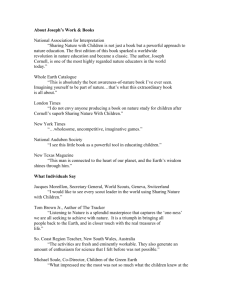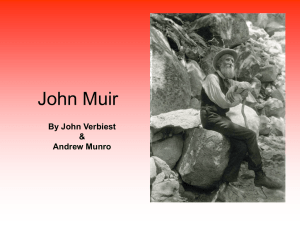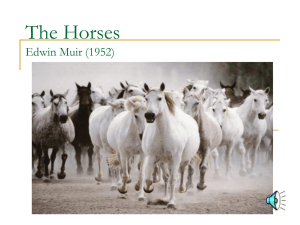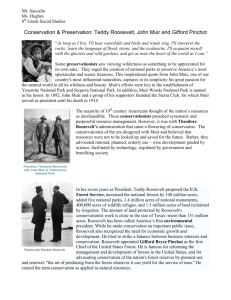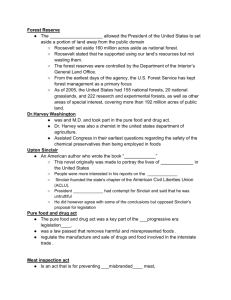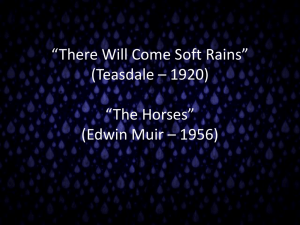John Muir – who would later aquire the nickname John o'Mountains
advertisement
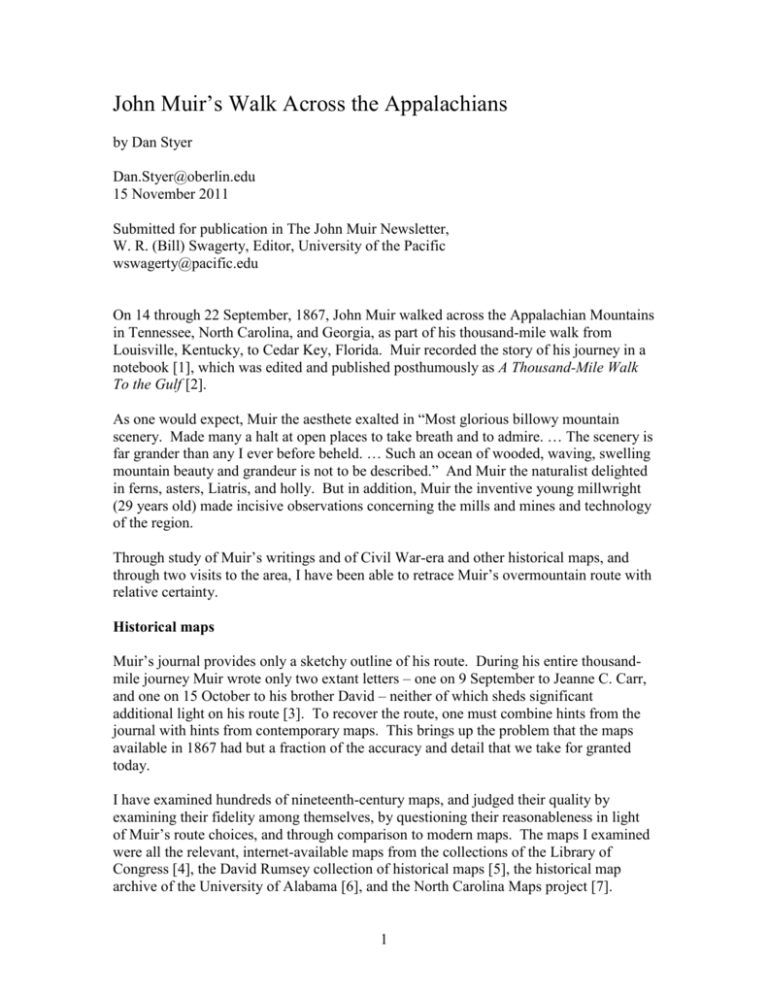
John Muir’s Walk Across the Appalachians by Dan Styer Dan.Styer@oberlin.edu 15 November 2011 Submitted for publication in The John Muir Newsletter, W. R. (Bill) Swagerty, Editor, University of the Pacific wswagerty@pacific.edu On 14 through 22 September, 1867, John Muir walked across the Appalachian Mountains in Tennessee, North Carolina, and Georgia, as part of his thousand-mile walk from Louisville, Kentucky, to Cedar Key, Florida. Muir recorded the story of his journey in a notebook [1], which was edited and published posthumously as A Thousand-Mile Walk To the Gulf [2]. As one would expect, Muir the aesthete exalted in “Most glorious billowy mountain scenery. Made many a halt at open places to take breath and to admire. … The scenery is far grander than any I ever before beheld. … Such an ocean of wooded, waving, swelling mountain beauty and grandeur is not to be described.” And Muir the naturalist delighted in ferns, asters, Liatris, and holly. But in addition, Muir the inventive young millwright (29 years old) made incisive observations concerning the mills and mines and technology of the region. Through study of Muir’s writings and of Civil War-era and other historical maps, and through two visits to the area, I have been able to retrace Muir’s overmountain route with relative certainty. Historical maps Muir’s journal provides only a sketchy outline of his route. During his entire thousandmile journey Muir wrote only two extant letters – one on 9 September to Jeanne C. Carr, and one on 15 October to his brother David – neither of which sheds significant additional light on his route [3]. To recover the route, one must combine hints from the journal with hints from contemporary maps. This brings up the problem that the maps available in 1867 had but a fraction of the accuracy and detail that we take for granted today. I have examined hundreds of nineteenth-century maps, and judged their quality by examining their fidelity among themselves, by questioning their reasonableness in light of Muir’s route choices, and through comparison to modern maps. The maps I examined were all the relevant, internet-available maps from the collections of the Library of Congress [4], the David Rumsey collection of historical maps [5], the historical map archive of the University of Alabama [6], and the North Carolina Maps project [7]. 1 My comparisons show that the best available maps from the era of Muir’s walk are, for the northern portion, N. Michler’s 1862 “Map of middle and east Tennessee” [8] (which actually extends south to Blairsville, Georgia), and, for the southern portion, W.E. Merrill’s 1864 “Map of northern Georgia” [9]. The 1863 map “Mountain region of North Carolina and Tennessee” by W. L. Nicholson and A. Lindenkohl [10] has almost twice the scale but remains useful. David H. Burr’s 1839 “Map of Kentucky & Tennessee” [11] is older but still valuable. Another old but useful map is the 1837–1838 “Map of part of the Cherokee Territory Situated among the Mountains of N. Carolina, Georgia, and Tennessee” prepared by Philip Harry, C.E., under the direction of Captain W.G. Williams. This map was developed to support the “Trail of Tears” eviction of the Cherokee in 1838–39. A copy hangs in the lower level of the Cherokee County Historical Museum in Murphy, North Carolina. Also useful is the “General topographical map” by Julius Bien & Co. This map was issued by the United States War Department in 1895, but it was part of an “Atlas to Accompany the Official Records of the Union and Confederate Armies, 1861-1865” and seems to show features as they existed in 1865, not 1895. Sheets VII and VIII are the relevant maps [12]. None of these maps show features with the accuracy and scale that we are familiar with today. None of them show elevation contours. The earliest maps that we would today consider topographic maps are the 30 minute quadrangles [13] issued by the US Geological Survey in the 1890s and later. These were surveyed two or three decades after Muir’s walk, so they need to be used judiciously and in connection with the Civil War-era maps. Reconstructing the route In order to reconstruct Muir’s probable route, I read Muir’s book and journal for geographical clues, traced out a reasonable route on Civil War-era and earlier maps, transferred that route to topographical maps from the 1890s and later, and then transferred that route to modern maps. I have recorded the result of this process on Google maps [14]. This process is for the most part easier than it sounds, and while it cannot be and does not pretend to be exact, most individuals performing the process would come up with a route very similar to the one I produced. Here are my conclusions: From Philadelphia, Tennessee, to the vicinity of Tellico Plains. According to [1,2], Muir passed through Philadelphia and Madisonville on 14 September. He obtained a view of the Unaka Mountains and “Stayed overnight with a pleasant young farmer.” The next day he encountered “Most glorious billowy mountain scenery. Made many a halt at open 2 places to take breath and to admire. The road, in many places cut into the rock, goes winding about the knobs and gorges.” The village of Philadelphia, Tennessee, in October 2011. The Civil War-era map [8] shows only one reasonable route from Philadelphia to Madisonville, and only one reasonable route from Madisonville toward the Unaka Mountains – a route passing through the town of Mount Vernon. In the vicinity of Tellico Plains. Muir spent the night of 15 September with a talkative “old gentleman”, who convinced Muir to share his home until the morning of 19 September. Muir does not name the “old gentleman” but took to calling him “my worthy entertainer” in his journal. Nor does Muir give a location, but (as we shall see in a moment) it must have been in or near the town of Tellico Plains, at the foot of the Unaka Mountains. Since starting from Louisville, Kentucky on 2 September, Muir had spent 14 nights at 14 different locations, always making progress southward. We know from his 8 September letter to Jeannie Carr [3] that he was lonely (“I hardly dare to think of home and friends”), and apparently the “old gentleman” was too. So on 16 September Muir did not progress southward, but instead visited a gold mine. Nuggets of gold were discovered in the bed of Coker Creek in Monroe County, Tennessee in 1827, sparking the first “gold rush” in United States history [15]. (The land was at that time owned by the Cherokee Nation, but the natives were removed when 3 Andrew Jackson’s Indian Removal Act of 28 May 1830 led to their “Trail of Tears” eviction in 1838–39. The gold rush had essentially ended by 1850, when miners moved on to California, but small amounts of gold are found in Coker Creek even today.) The gold belt extends throughout Coker Creek and along the Whippoorwill Branch of the Tellico River, but the town of Coker Creek is located 6 miles south of Tellico Plains. Muir erred when he said that “gold is found in small quantities throughout the Alleghenies” – the gold mine could have been located only in this vicinity. On 17 September Muir again made no progress southward, but instead inspected a grist mill built by “John Vohn”. The federal census of Monroe County taken three years after Muir’s walk shows no one named “Vohn” anywhere in the county [16]. However, it does list John Vaughn, born 1847, living in “District 18: Jalapa – from Tellico Plains toward McMinn Co. line & Polk Co. line”. (Not to be confused with former Sheriff and Confederate General John Crawford Vaughn, 21 February1824 – 10 September 1875, of Sweetwater, Monroe County.) Once again, we have Muir located not far south of Tellico Plains. On 18 September Muir walked “Up the mountain on the [Tennessee – North Carolina] state line. The scenery is far grander than any I ever before beheld. The view extends from the Cumberland Mountains on the north far into Georgia and North Carolina to the south, an area of about five thousand square miles. Such an ocean of wooded, waving, swelling mountain beauty and grandeur is not to be described.” After this excursion he walked back down and again spent the night with the “old gentleman”. It is impossible to know which summit Muir climbed on 18 September, but it’s worth noting that on the ridge immediately east of Tellico Plains, only two summits are prominent enough to enjoy names. These are Waucheesi Mountain (elevation 3692 feet) and Cantrell Top (elevation 3600 feet). Cantrell Top is actually on the state line, but Waucheesi Mountain is so close (and boundary surveying and marking was so irregular in 1867) that Muir could easily have ascended this summit and mistaken it for being on the state line. I have enjoyed speculating on the characteristics of Muir’s “worthy entertainer”. The term “old gentleman” usually refers to someone older than one’s father. His talkativeness suggests a widower living alone or with few other people, with whom he has little in common. The 1870 federal census [16] shows that of 1425 individuals living in districts 14, 18, and 19 (Tellico Plains and points south) there were only five single men above the age of 66 (the age of Muir’s father at the year of this census): Isac Stephens, M.C. Stephens, Alen Jones, David Dean, and Aug Presswood. To my mind, the most likely candidate is David Dean who (at the time of the census) was 71 years old and living with only the 18-year-old Martha Dean, presumably a grandchild. Dean’s home lay in census district 18, south of Tellico Plains proper. Over the Unaka Mountains. On 19 September Muir bade good-bye to the “old gentleman”, who regaled him with a final story concerning Trap Gap, and walked on to Murphy, North Carolina. Civil War-era maps show one or two routes over the Unaka 4 Mountains from Tellico Plains to Murphy. All maps show a more southerly route over Unicoi Gap, a route called the Unicoi Turnpike (marked “Unaka TurnPike” on map [8]). Some maps also show a more northerly route up the Tellico River in Tennessee and then down the Beaverdam Creek in North Carolina, but there is considerable variation in this route from one map to another and, as mentioned, some maps omit it altogether. The Unicoi Turnpike route almost certainly was a better constructed and maintained route, was safer from the lawless armed bands of “bushwhackers” that roamed the South so soon after the end of the Civil War, had less elevation gain and loss, and was (if our earlier surmise that the “old gentleman” lived south of Tellico Plains is correct) shorter. The distance from Tellico Plains to Murphy along the Unicoi Turnpike is already 26 miles, and even for a good walker like Muir it wouldn’t seem to make sense to take a longer and more difficult route. I surmise that Muir rejected the northerly route (if it existed at all) and took the Unicoi Turnpike to cross the Unaka Mountain ridge at Unicoi Gap. Ridgeline of the Unaka Mountains viewed from Doc Rogers Field on the Joe Brown Highway 0.3 mile east of the town of Coker Creek, Tennessee. “Most glorious billowy mountain scenery. … Such an ocean of wooded, waving, swelling mountain beauty and grandeur is not to be described.” This is a storied route. The major Cherokee route connecting communities east and west of the Appalachian Mountains – the Wachesa Trail – passed over Unicoi Gap [17]. The Unicoi Turnpike was constructed near or on the Wachesa Trail during 1815 – 1817 by James R. Wylie and company, running from near Maryville, Tennessee, to Vonore, Tennessee, to Tellico Plains, Tennessee, to Murphy, North Carolina, to Helen, Georgia, and finally to the Tugalo River, east of Toccoato in northern Georgia. The portion from 5 Vonore, Tennessee, to Murphy, North Carolina, was designated a National Millennium Flagship Trail in 2001. The modern gravel “Joe Brown Highway” closely follows the route of the old Unicoi Turnpike from Coker Creek, Tennessee, to Murphy, North Carolina, and following this remote “highway” is one of the great delights in retracing Muir’s thousand-mile route. Tall White Pines growing beside the trace of the old Unicoi Turnpike. 6 One Civil War-era map [8] shows the Unicoi Turnpike traveling from Tellico Plains to Unicoi Gap in an indirect way so as to pass through the town of Towee Falls. (This town grew up around a mill exploiting the power of a waterfall. The town no longer exits, but the waterfall does.) However archeological evidence [18] suggests that the Turnpike, and thus probably Muir, took a more direct route. The route sketched out in [18], as elaborated by the topographic maps [13], is the one I have adopted for my estimated route [14]. In Murphy, North Carolina. Muir spent the night of 19 September, and all the next day and night, at the home of “Mr. Beale,” the sheriff. William Beal (born 22 October 1820, in Whitehall, Yorkshire, England, died 3 October 1898, in Murphy) served as sheriff of Murphy during the Civil War [19]. He had attended Oxford University, and was a surveyor, a merchant, a teacher at Mount Pleasant Academy in Murphy, a founder of the Episcopal Church of the Messiah in Murphy [20], and a collector of stones and fossils [21]. In later years, he would teach in Macon County, North Carolina, 50 miles away from Murphy, and while so employed he walked home to Murphy every Friday evening and back to work on every Sunday afternoon. In short, he was the sort of man who would get along well with Muir, and indeed Muir relished two nights in “a house decked with flowers and vines, clean within and without, and stamped with the comforts of culture and refinement.” William Beal’s “house decked with flowers and vines” in Murphy, North Carolina, where Muir spent the nights of 19 and 20 September. Photo reproduced from [23]. This home was located across the Hiwassee River from downtown Murphy, just south of the current US-19. By 1887, William Beal was taking on summer-long vacationing boarders [22], and after his death that practice was continued by two of his children, Mary and Ralph, who never married. After their deaths, the house was demolished to make way for a Murphy Housing Authority project called Beal Circle. The Beal family cemetery, however, survives and is marked on the map [14]. A photograph of the nowdemolished Beal home, courtesy of Mrs. Kenneth Beal Farmer, appears in A Pictorial 7 History of Cherokee County [23]. The portion of Murphy south of both US-19 and the Hiwassee River is still called “Bealtown”. (For example, there is a “Bealtown Baptist Mission” at 60 Chapel Street.) Tombstone of John Muir’s host, William Beal, situated in Murphy, North Carolina immediately south of the home where Muir spent the nights of 19 and 20 September. The inscription reads “Wm Beal/Born/Yorkshire Eng./Oct 27 1820/Died/Oct 3 1898”. Latitude: 35.07785°, Longitude: 84.03542°. 8 Over the Blue Ridge. On 21 September Muir left Murphy, and passed through Blairsville, Georgia. About noon on 22 September he crossed the Blue Ridge, “the last mountain summit on my way to the sea,” and he spent the night in the town of Mount Yonah (now known as Cleveland [24]). The important question regarding this segment is where Muir crossed the Blue Ridge. Civil War-era maps show two roads from Blairsville to Mount Yonah: one crossing at Frogtown Gap (known today as Neels Gap) the other crossing four miles to the east at Tesnatee Gap. The main route from 1840 to 1922 was the “Union Turnpike” (called “Logan Turnpike” after 1871) which passed over the Tesnatee Gap [24]. The Frogtown Gap route is referred to as an “Indian Trail” and it does not appear at all in the 1903 Dhalonega quadrangle [13]. In 1922 the paved road over Frogtown Gap was completed (its name was changed to Neels Gap in honor of W.R. Neel, the head engineer of the survey team for the road) and the Logan Turnpike fell into disrepair. The part of Logan Turnpike north of the gap became in 1966 the Richard B. Russell Scenic Highway (GA-348). The two miles south of the gap, east of Town Creek, is now the Logan Turnpike foot trail and is protected within the Raven Cliffs Wilderness Area. The part of Logan Turnpike south of the Wilderness Area is now called “Toll Gate Road.” According to Gordron Winkler, son of the last Logan Turnpike gatekeeper [24], taking the toll road would not have been an undue financial burden on Muir, because “A walker didn’t have to pay nuthin’.” The Tesnatee Gap route would have been shorter and better constructed. I surmise that this is the route that Muir likely took. A visit today In his thousand-mile walk, Muir sought out “the wildest, leafiest, and least trodden way I could find.” The actual crossings of the Unaka Mountains and the Blue Ridge remain relatively wild, leafy, and untrodden, but other parts of Muir’s route have been buried under reservoirs and superhighways. Starting at Unicoi Gap, and proceeding two miles northward, a portion of the historical Unicoi Turnpike has been marked as a hiking trail. There one can follow the still-welldefined wagon trace and experience the wild and leafy Unaka Mountains very much as Muir would have experienced them in 1867. In addition, the web site [14] lists several other sites to visit, from waterfalls to balds to virgin forests, that will help the modern-day visitor share some of the exaltation and education that Muir experienced. 9 Acknowledgements Father James A. Johnson, Rector of the Episcopal Church of the Messiah in Murphy, North Carolina, shared with me church records concerning the Beal family, and invited me into his home for dinner and into the beautiful 1896 church building at 76 Peachtree Street for a tour. The mechanics at Murphy Xpress Lube went out of their way to do a rapid repair job on my car when a trouble light turned on during my May 2010 visit. Endnotes [1] Digitized images of Muir’s notebooks are available through http://library.pacific.edu/ha/digital/muirjournals/muirjournals.asp See journal number 1, images 14 through 19. [2] John Muir, A Thousand-Mile Walk To the Gulf, edited by William Frederic Badè (Houghton Mifflin Company, Boston, November 1916). Muir died on 24 December 1914. [3] http://library.pacific.edu/ha/digital/muircorrespondence/muircorrespondence.asp [4] http://memory.loc.gov/ammem/gmdhtml/gmdhome.html [5] http://www.davidrumsey.com/ [6] http://alabamamaps.ua.edu/historicalmaps/index.html [7] http://www.lib.unc.edu/dc/ncmaps/ The “North Carolina Maps” project is a collaboration between the North Carolina State Archives, the Outer Banks History Center, and the University Library at University of North Carolina – Chapel Hill. [8] N. Michler, “Map of middle and east Tennessee,” 1862, scale 1:235,000. Available through http://hdl.loc.gov/loc.gmd/g3962t.cws00162 [9] William Emery Merrill, “Map of northern Georgia,” 1864, scale 1:253,440. Available through http://hdl.loc.gov/loc.gmd/g3920.cws00029 [10] W. L. Nicholson and A. Lindenkohl, “Mountain region of North Carolina and Tennessee,” 1863, scale 1:633,600. Available through http://hdl.loc.gov/loc.gmd/g3900.cw0053000 10 [11] David H. Burr, “Map of Kentucky & Tennessee,” 1839, scale 1:650,000. Available through http://hdl.loc.gov/loc.gmd/g3950.rr002240 [12] Julius Bien & Co., “General topographical map,” sheets VII and VIII, (United States War Department, 1895) scale 1:633,600. Available through http://www.davidrumsey.com/detail?id=1-1-26974-1100273 http://www.davidrumsey.com/detail?id=1-1-26975-1100274 [13] These USGS 30 minute quadrangles (scale 1:125,000) are relevant: Loudon, Tennessee, “Edition of Oct. 1895. Topography by F.M.Pearson 1884-5. Topography by C.E.Cooke 1891.” Murphy, Tennessee – North Carolina, “Edition of Sep. 1914, reprinted 1927. Topography by F.M.Pearson, Chas.M.Yeates and Chas.E.Cooke. Surveyed in 1884-1885 and 1892. Partial revision in 1911-1912 by J.I.Gayetty.” Above available through http://alabamamaps.ua.edu/historicalmaps/us_states/tennessee/topos/30mintopos.html Ellijay, Georgia – North Carolina – Tennessee, “Edition of May 1898. Topography by W.L.Miller R.H.Mc.Kee and A.E.Murlin. Surveyed in 1895-96.” Dahlonega, Georgia – North Carolina, “Edition of Feb. 1903, reprinted 1922. Topography by W.M.Beaman, Albert Pike, and Geo.H.Guerdrum. Surveyed in 1894 and 1900.” Above available through http://alabamamaps.ua.edu/historicalmaps/us_states/georgia/topos/30mintopos.html [14] “John Muir’s Walk Across the Appalachians”. Available through http://maps.google.com/ An internet search for “John Muir’s Walk Across the Appalachians” will locate this map. [15] G.H. Ashley, “The gold fields of Coker Creek, Monroe County, Tennessee” in Resources of Tennessee volume 1 (Tennessee Geological Survey, 1911) pages 78-107. David Williams, The Georgia Gold Rush: Twenty-Niners, Cherokees, and Gold Fever (University of South Carolina Press, Columbia, SC, 1995). [16] Data from the 1870 federal census of Monroe County, Tennessee, are available at http://www.tngennet.org/monroe/1870/INDEX.HTM http://www.tngennet.org/monroe/modist.htm [17] Vicki Rozema, Footsteps of the Cherokees: A Guide to the Eastern Homelands of the Cherokee Nation (John F. Blair Publisher, Winston-Salem, NC, 2007). [18] Barbara R. Duncan and Brett H. Riggs, Cherokee Heritage Trails Guidebook (University of North Carolina Press, Chapel Hill, NC, 2003). 11 [19] Margaret Walker Freel, Our Heritage: The People of Cherokee County, North Carolina, 1540 – 1955 (Miller Printing Company, Asheville, NC, 1956) pages 79, 170, 254–255. Alice D. White, editor, The Heritage of Cherokee County, volume I (Cherokee County Historical Museum, Winston-Salem, NC, 1987) pages 16, 79, 520. Alice D. White, editor, The Heritage of Cherokee County, volume II (Cherokee County Historical Museum, Roswell, GA, 1990) pages 6, 62. Nell Amos White, editor, The Heritage of Cherokee County, volume III (Cherokee County Historical Museum, Waynesville, NC, 2006) pages 115–116, 316. Archives of the Episcopal Church of the Messiah in Murphy, North Carolina. http://www/findagrave.com/cgi-bin/fg.cgi?page=gr&Gid=20976294 [20] The Rev. A. Rufus Morgan, priest-in-charge of Messiah from 1940 to 1951, was instrumental in building and maintaining the Appalachian Trail in southwestern North Carolina. [21] W.C. Kerr, Report of the Geological Survey of North Carolina, volume I (Josiah Turner, State Printer and Binder, Raleigh, NC, 1875) pages xviii, 71. Henry G. Hanks, Fifth Annual Report of the State Mineralogist, for the year ending May 15, 1885 (California State Mining Bureau, Sacramento, California, 1885) page 224. [22] “Brook Trout in Georgia”, Forest and Stream: A Journal of Outdoor Life, Travel, Nature Study, Shooting, Fishing, Yachting volume XXVIII, number 26, page 555 (21 July 1887). According to this source, Beal “often ascended [Mount Butler] with his friends” where they sat on “a ledge of rocks at the summit.” Perhaps this summit is the present-day “Fort Butler Mountain”, and perhaps this was the mountain climbed by Muir on 20 September. [23] Bob Satterwhite, editor, A Pictorial History of Cherokee County (Cherokee County Historical Museum, Murphy, NC, 1995), page 133. [24] White County History Book Committee, A History of White County 1857–1980 (Cleveland, Georgia, 1981) pages 11–12, 390. 12
